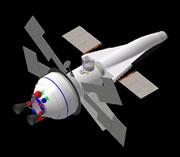 The shuttle is the only craft capable of finishing construction of the International Space Station.© NASA
The shuttle is the only craft capable of finishing construction of the International Space Station.© NASADiscovery's return to flight marks the beginning of the end for the space-shuttle fleet, which is expected to retire in five years' time.
After the Columbia shuttle disintegrated in 2003, the investigation board recommended that, before 2010, NASA should test every single component in its fleet to the standard of completely new vehicles. The cost of re-certifying the three remaining craft would have been enormous, and as NASA already planned to develop a Crew Exploration Vehicle (CEV) to replace the shuttles, their demise was assured. Instead of full re-certification, they opted for safety modifications for all three craft instead (see 'Discovery - the improved shuttle' interactive graphic).
NASA administrator Mike Griffin is now pushing hard to ensure that the CEV is ready to take over when the shuttles leave off. It will eventually deliver astronauts to the Moon and even Mars as part of NASA's vision for space exploration.
Given that the shuttles have fewer than five years left in which to operate, it may seem strange to have spent two years upgrading the craft. But without them, the International Space Station (ISS) would remain unfinished. A shuttle is the only spacecraft that can lift the station's modules into space, along with the crew needed to fit them together.
Construction contracts
 One possible design for the Crew Exploration Vehicle.© Lockheed Martin
One possible design for the Crew Exploration Vehicle.© Lockheed MartinThe United States holds the responsibility for finishing construction of the ISS. In a statement to the US House science committee on the future of NASA on 28 June, Griffin reaffirmed that the station will be completed before 2010.
But this might be tricky. Last year, Bill Gerstenmaier, manager of the ISS programme, expected that he would have 28 shuttle flights to build and fully stock the station so that it could operate until 2016 (see 'Space station strategy' ). Thanks to budget shuffles and the challenge of cramming 28 flights into five years, this may be reduced to 18 flights - just enough to finish construction alone. So, to make up the shortfall, the United States will have to buy flights from other countries or even private companies.
To make this easier, Griffin wants to amend the Iran Nonproliferation Act that was made US law in 2000. This act stops NASA making payments to Russia's space agency for as long as the United States thinks that Russia is failing to oppose the transfer of weapons to Iran.
As a major partner in the ISS, Russia has been keeping the station crewed with its Soyuz capsules, and supplying them using unmanned Progress modules. But their agreement to provide this service free of charge expires in April 2006, so NASA will need to be able to buy Russian services to carry astronauts and cargo to the station (see 'US willing to pay for Russia's help in space').
Although many are sceptical about the scientific value of the ISS, it has provided ample opportunity to learn how lengthy trips in microgravity affect the human body. It has also highlighted many of the pitfalls of space construction, and is helping to shape plans to build a permanent Moon base.
Slimmed-down craft
Although the shuttles are nearing the end of their life, the rockets that blast them into space may be used for many years to come. Griffin believes that the twin boosters and fuel tank, on which shuttles piggyback, could be adapted as a 'heavy lifter' to deliver cargo to space.
Future manned missions will probably be accomplished by the CEVs, whose main purpose will be getting people back to the Moon as early as 2015. The CEV will look very different from the space shuttle, which is essentially a bulky, sluggish space truck for heavy construction in low Earth orbit. The CEV is likely to be a slimmed-down, modular craft, a bit like the old Apollo design that was designed to take people far out of orbit.
On 13 June, NASA announced that two rival teams will bid for the contract to build the CEV. Lockheed Martin will produce one design, while a combination of Northrop Grumman and Boeing will work on the other, with the winning design to be chosen in 2006. Stay tuned for the winner.
